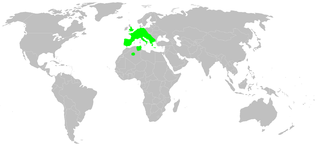
Episinus maculipes is a rare European spider of the family Theridiidae. The known distribution is "England to Algeria, Ukraine, Russia".

Episinus is a genus of comb-footed spiders that was first described by Pierre André Latreille in 1809.

Episinus angulatus is a small mottled brownish tangle-web spider, found from Europe to Russia.

Segestria senoculata, sometimes known as the snake-back spider, is a species of spider belonging to the family Segestriidae. It has a Palearctic distribution.

Enoplognatha ovata is a species of spiders belonging to the family Theridiidae.

Pholcus phalangioides, commonly known as daddy long-legs spider or long-bodied cellar spider, is a spider of the family Pholcidae. It is also known as the skull spider due its cephalothorax resembling a human skull. This is the only spider species described by the Swiss entomologist Johann Kaspar Füssli, who first recorded it in 1775. Its common name of "daddy long-legs" should not be confused with a different arachnid species with the same common name, the harvestman (Opiliones).

Harpactea rubicunda is a spider species found in Georgia. It is also found in Lithuania.

Ero cambridgei is a pirate spider species with Palearctic distribution. It is notably found in Lithuania.

Ero furcata is a pirate spider species with Palearctic distribution. It is notably found in Lithuania and the Czech Republic.

Hyptiotes paradoxus is a spider species with Palearctic distribution. It is notably found in Lithuania and Latvia. It is also found in Estonia and Finland.

Crustulina guttata is a spider species with Palearctic distribution. It is notably found in Lithuania.
Cryptachaea riparia is a spider species with Palearctic distribution. It is notably found in Lithuania.

Enoplognatha thoracica is a spider species with Holarctic distribution. It is notably found in Lithuania.

Euryopis flavomaculata is a tangle-web spider species with Palearctic distribution. It is notably found in Lithuania.

Platnickina tincta is a tangle web spider species with Holarctic distribution. It is notably found in Lithuania.

Lasaeola prona is a tangle web spider species with Holarctic distribution. It is notably found in Lithuania.
Lasaeola tristis is a tangle web spider species found from Europe to Central Asia. It is notably found in Lithuania.
Lessertia dentichelis is a spider species found in Europe, Canary Islands, Madeira, Canada and New Zealand. It is notably found in Lithuania. There is also a notable population in Kungsträdgården metro station, in Stockholm; this is the only place in Northern Europe where the species can be found. Presumably the spider traveled to Sweden on machines and equipment from Southern Europe when the station was being constructed in the early 1970s.
Episinus amoenus is a species of cobweb spider in the family Theridiidae. It is found in the United States and Mexico.















